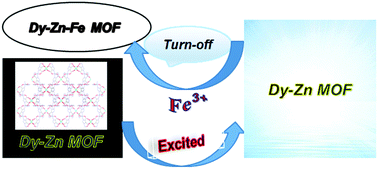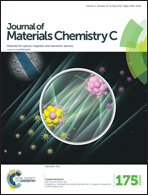Luminescence tuning of the Dy–Zn metal–organic framework and its application in the detection of Fe(iii) ions†
Abstract
A new Dy(III)–Zn(II) heterometallic-organic framework [H(H2O)8][DyZn4(imdc)4(im)4] (Dy–Zn MOF) (H3imdc = 4,5-imidazole dicarboxylic acid, im = imidazole) was synthesized under the hydrothermal conditions and characterized by single-crystal X-ray diffraction. The Dy–Zn MOF possesses the characteristic Dy(III) emission with a lifetime and a quantum yield of 54.65 μs and 5.5%, respectively, when excited at 290 nm. The luminescence of the Dy–Zn MOF can be tuned by the excitation wavelength to give white-light and yellow emissions based on emissions of Dy3+ and the ligands imdc3− and im. The energy transfer pathways at different excitation wavelengths were discussed. Furthermore, the Dy–Zn MOF can act as a turn-off chemosensor for Fe3+ with high selectivity and sensitivity. The resultant species at different molar ratios of Dy–Zn MOF and Fe3+ in the response system were obtained and have the general formula [H(H2O)8][DyZn4−xFex(imdc)4(im)4−x(OH)x] with the same framework as the Dy–Zn MOF. The sensing mechanism could be described as the adsorption of Fe3+ and displacement of Zn2+ by paramagnetic Fe3+ in the Dy–Zn MOF to form the Dy–Zn–Fe MOF, resulting in fluorescence quenching. The quenching constant was determined to be 9.29 × 105 M−1.


 Please wait while we load your content...
Please wait while we load your content...